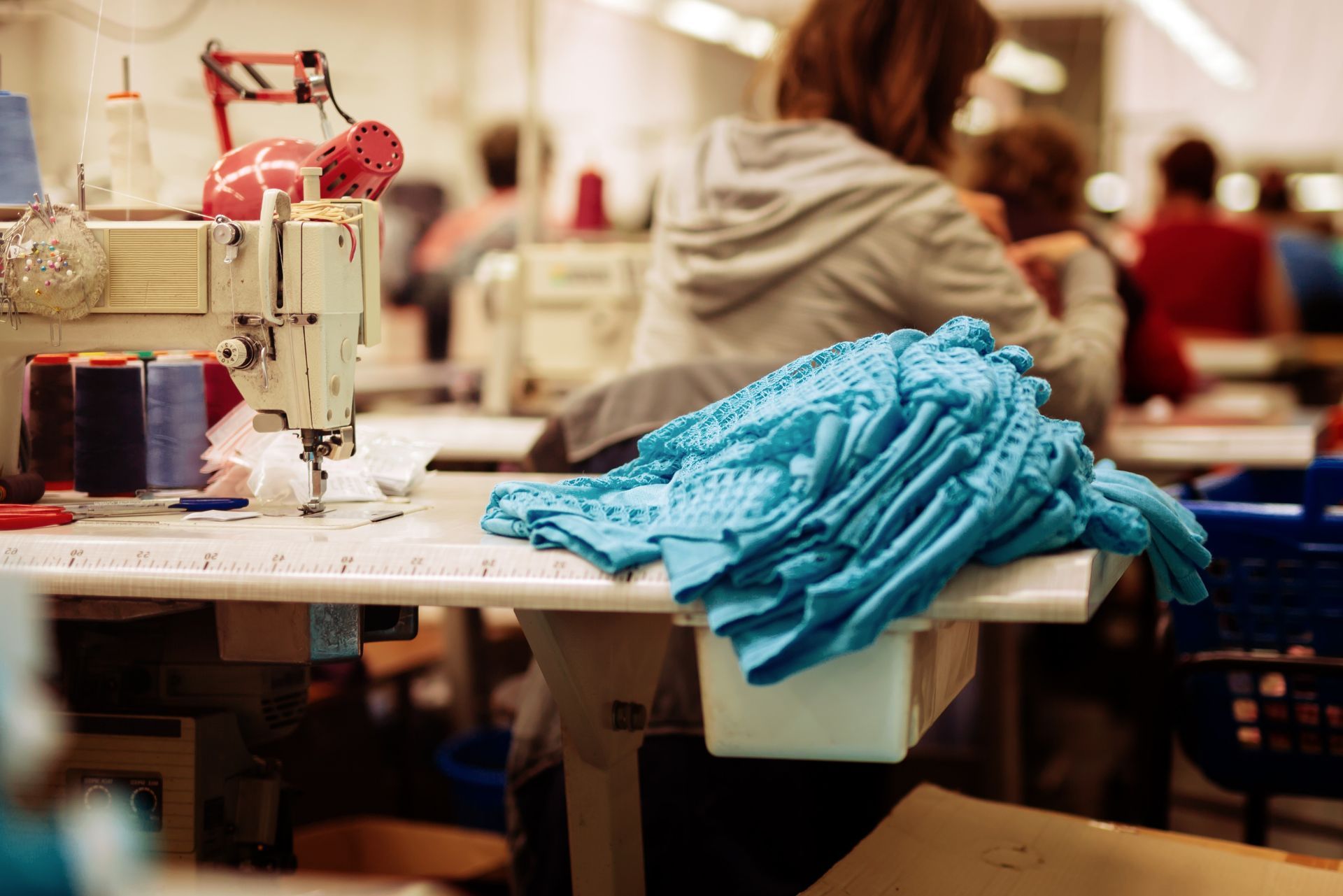California Textile & Apparel Manufacturing Insurance

9:00am - 6:00pm Mon-Fri
Will Reply in 15min*
Top 3 Recommended Policies
Index
Overview of the Textile & Apparel Manufacturing Industry in California
Why Specialized Insurance is Essential for Textile & Apparel Manufacturers
Types of Insurance Coverage for California Textile & Apparel Manufacturers
Regulatory Considerations and Compliance in California
How to Choose the Right Insurance Provider
Risk Management Tips for Textile & Apparel Manufacturers
Conclusion: Protecting Your California Textile & Apparel Manufacturing Business
The textile and apparel manufacturing industry in California is a vibrant and essential part of the state’s economy. From small boutique designers to large-scale manufacturers, businesses in this sector face unique risks that require
specialized insurance coverage. Understanding the nuances of California textile and apparel manufacturing insurance is crucial for protecting your business assets, employees, and overall operations.
Overview of the Textile & Apparel Manufacturing Industry in California
California has long been a hub for textile and apparel manufacturing, blending creativity with industrial prowess. The state’s diverse workforce and access to international markets make it an attractive location for manufacturers. According to the California Fashion Association, the state’s fashion and apparel industry generates over $66 billion annually and employs more than 500,000 people directly and indirectly.
Despite competition from overseas manufacturers, California’s textile and apparel sector remains competitive by focusing on innovation, sustainable practices, and high-quality production. This industry encompasses a wide range of activities, including fabric production, garment manufacturing, design, and distribution. The presence of renowned fashion schools and design institutes in cities like Los Angeles and San Francisco further fuels creativity and innovation, allowing new designers to emerge and contribute to California's vibrant fashion scene.
Moreover, California's unique cultural landscape influences the styles and trends produced within the industry. The fusion of various cultural aesthetics often leads to groundbreaking designs that resonate not only locally but also globally. This cultural richness, combined with the technological advancements in textile manufacturing, such as 3D printing and smart textiles, positions California at the forefront of the fashion revolution.
Key Challenges in the Industry
While the industry offers significant opportunities, it also faces challenges. Fluctuating raw material costs, supply chain disruptions, labor shortages, and regulatory compliance are ongoing concerns. Additionally, the industry must navigate environmental regulations, particularly those related to chemical use and waste management. As consumers increasingly demand transparency and sustainability, manufacturers are pressured to adopt eco-friendly practices, which can sometimes lead to increased operational costs.
These challenges underscore the importance of having comprehensive insurance coverage tailored to the specific risks faced by textile and apparel manufacturers in California. Furthermore, the industry is witnessing a shift towards digital transformation, with
e-commerce and online retailing becoming more prevalent. This transition requires manufacturers to adapt quickly, not only in terms of production but also in marketing and distribution strategies, to meet the evolving demands of consumers who seek convenience and immediacy in their shopping experiences.

Why Specialized Insurance is Essential for Textile & Apparel Manufacturers
Textile and apparel manufacturing businesses encounter a variety of risks that general business insurance policies may not fully cover. Specialized insurance policies are designed to address these unique exposures, providing peace of mind and financial protection.
Common Risks in Textile & Apparel Manufacturing
Some of the most common risks include:
- Property Damage: Factories and warehouses are vulnerable to fire, theft, and natural disasters such as earthquakes and floods, which are particularly relevant in California.
- Equipment Breakdown: Manufacturing machinery and equipment are costly and critical to operations. Breakdowns can lead to significant downtime and financial loss.
- Product Liability: Defective products or those that cause injury can result in costly lawsuits.
- Employee Injuries: Manufacturing environments pose risks of accidents and injuries, necessitating workers’ compensation coverage.
- Supply Chain Interruptions: Delays or disruptions can affect production schedules and revenue.
Benefits of Industry-Specific Insurance
Insurance policies tailored to the textile and apparel manufacturing sector often include coverage extensions and endorsements that address these risks more comprehensively than standard policies. For example, coverage might include protection for raw materials in transit, spoilage of inventory due to equipment failure, or business interruption caused by supply chain issues.
Additionally, insurers with experience in this industry can offer risk management advice, helping businesses implement safety protocols and reduce insurance premiums over time.
Moreover, specialized insurance can also provide coverage for intellectual property, which is increasingly vital in a competitive market where designs and branding play a crucial role in a company's success. Protecting trademarks and patents against infringement can save manufacturers from costly legal battles and help maintain their market position. Furthermore, as sustainability becomes a focal point in the textile industry, insurance policies can be adapted to cover eco-friendly practices, such as liability related to the use of sustainable materials or compliance with environmental regulations.
Another important aspect of specialized insurance is the ability to customize policies based on the unique needs of each manufacturer. For instance, a small boutique manufacturer may have different coverage needs compared to a large-scale operation. This flexibility allows businesses to ensure that they are not over-insured or under-insured, optimizing their insurance costs while still receiving adequate protection. Additionally, with the rise of e-commerce, policies can also be designed to cover risks associated with online sales, including cyber liability and data breaches, which are becoming increasingly pertinent in today’s digital landscape.
Types of Insurance Coverage for California Textile & Apparel Manufacturers
Understanding the various types of insurance available is critical for building a robust risk management strategy. The following are the most relevant coverages for textile and apparel manufacturers in California.
1. General Liability Insurance
This foundational coverage protects businesses against claims of bodily injury, property damage, and personal injury caused by business operations. For example, if a visitor slips and falls in a manufacturing facility, general liability insurance can cover medical expenses and legal fees.
Given the public and employee interactions typical in manufacturing settings, this coverage is indispensable. It not only safeguards the financial health of the business but also fosters a culture of safety and accountability within the workplace, encouraging manufacturers to implement best practices and training programs to minimize risks.
2. Commercial Property Insurance
Protecting physical assets, commercial property insurance covers damage to buildings, equipment, inventory, and raw materials caused by fire, theft, vandalism, and natural disasters. California’s susceptibility to wildfires and earthquakes makes this coverage particularly important.
Manufacturers should consider endorsements for earthquake coverage, as it is not included in standard property policies. Additionally, investing in risk mitigation strategies, such as fire-resistant materials and robust security systems, can further enhance protection and potentially lower insurance premiums.
3. Workers’ Compensation Insurance
California law requires employers to carry workers’ compensation insurance to cover medical expenses and lost wages for employees injured on the job. Textile and apparel manufacturing can involve hazardous machinery and repetitive tasks, increasing the risk of workplace injuries.
Having this coverage not only complies with state law but also supports employee welfare and reduces liability. Furthermore, a proactive approach to workplace safety, including regular training and ergonomic assessments, can help minimize injury rates and foster a more productive work environment.
4. Equipment Breakdown Insurance
This coverage protects against the cost of repairing or replacing damaged machinery and equipment due to mechanical failure, electrical issues, or operator error. Since manufacturing equipment is often expensive and essential for production, this insurance helps minimize downtime and financial loss.
Moreover, manufacturers can benefit from regular maintenance and inspections of their equipment to reduce the likelihood of breakdowns, which not only helps in maintaining operational efficiency but can also lead to lower insurance costs over time.
5. Product Liability Insurance
Product liability insurance covers claims arising from defective or harmful products. For apparel manufacturers, this could include issues like fabric defects causing skin irritation or faulty construction leading to injury.
This coverage is critical to protect against lawsuits and reputational damage. In an era where consumer awareness is heightened, manufacturers must prioritize quality control and compliance with safety standards to mitigate risks associated with product liability claims.
6. Business Interruption Insurance
Also known as business income insurance, this coverage compensates for lost income and ongoing expenses if a business must temporarily close due to a covered event, such as a fire or natural disaster. Given the complexity of supply chains and production schedules, this insurance can be a financial lifesaver.
In addition to financial protection, having a solid business continuity plan in place can help manufacturers respond swiftly to disruptions, ensuring that they can resume operations as quickly as possible and maintain customer trust during challenging times.
7. Inland Marine Insurance
Inland marine insurance covers goods, materials, and equipment while in transit or stored offsite. For textile and apparel manufacturers shipping raw materials or finished products, this coverage protects against loss or damage during transportation.
Beyond protecting physical assets, this insurance can also provide peace of mind, allowing manufacturers to focus on their core operations without the constant worry of potential losses during transit. Additionally, understanding the logistics and routes used for shipping can help manufacturers optimize their supply chain and reduce risks associated with transportation.
Regulatory Considerations and Compliance in California
Operating a textile or apparel manufacturing business in California means navigating a complex regulatory landscape. Insurance is just one aspect of compliance, but it plays a critical role in risk management. Understanding the nuances of these regulations is essential for business owners to ensure not only legal compliance but also the protection of their assets and workforce.
California Workers’ Compensation Requirements
California requires all employers with one or more employees to carry workers’ compensation insurance. The state’s Division of Workers’ Compensation enforces strict rules to ensure injured workers receive timely benefits. This insurance provides coverage for medical expenses and lost wages, fostering a safer workplace environment. Employers are also encouraged to implement safety programs and training to minimize workplace injuries, which can lead to lower insurance premiums over time.
Failure to comply can result in severe penalties, including fines and potential criminal charges. Moreover, the reputational damage from non-compliance can deter potential employees and clients, making it crucial for businesses to prioritize adherence to these regulations.
Environmental Regulations
Textile manufacturing often involves chemicals and dyes that are subject to environmental regulations at the state and federal levels. The California Environmental Protection Agency (CalEPA) and the California Air Resources Board (CARB) impose standards to control emissions and waste disposal. These regulations are designed to protect California's diverse ecosystems and public health, making it imperative for manufacturers to stay informed about the latest compliance requirements.
Insurance policies may include environmental liability coverage to protect against claims related to pollution or contamination. Additionally, businesses are encouraged to adopt sustainable practices, such as using eco-friendly materials and implementing waste reduction strategies, which not only help meet regulatory requirements but can also enhance brand reputation and attract environmentally conscious consumers.
Fire and Safety Codes
Manufacturing facilities must adhere to fire safety regulations enforced by local fire departments and the California Occupational Safety and Health Administration (Cal/OSHA). Compliance reduces the risk of accidents and can influence insurance premiums. Regular fire drills, proper storage of flammable materials, and maintaining clear exit routes are all essential practices that contribute to a safer working environment.
Furthermore, businesses should consider conducting regular safety audits and training sessions to ensure that all employees are aware of fire safety protocols. By fostering a culture of safety and preparedness, companies not only protect their workforce but also enhance their operational efficiency, ultimately leading to a more resilient business model in the competitive textile industry.
How to Choose the Right Insurance Provider
Selecting the right insurance provider is as important as choosing the right coverage. Textile and apparel manufacturers should seek insurers with expertise in the industry and a strong presence in California.
Industry Expertise
Insurers familiar with textile and apparel manufacturing understand the unique risks and can offer customized policies. They are also better equipped to provide risk management resources and claims support tailored to the industry. For instance, they may offer specialized coverage for equipment breakdowns, inventory loss, or liability arising from product defects, which are common concerns in this sector. Furthermore, these insurers often have access to industry-specific data, allowing them to assess risks more accurately and provide insights that can help manufacturers mitigate potential issues before they arise.
Financial Stability and Reputation
Choosing an insurer with strong financial ratings ensures that claims will be paid promptly and reliably. Checking reviews, industry ratings from agencies like A.M. Best, and testimonials from other manufacturers can provide insight into an insurer’s reputation. Additionally, it is wise to investigate the insurer's history of claims payment and customer satisfaction. Engaging with industry peers through forums or trade associations can also yield valuable recommendations and warnings about certain providers, helping you make a more informed decision.
Coverage Flexibility and Pricing
Look for providers that offer flexible policy options and endorsements that fit your specific needs. Comparing quotes from multiple insurers helps ensure competitive pricing without sacrificing coverage quality. Be mindful of the fine print in policy documents, as some insurers may offer lower premiums but include exclusions that could leave your business vulnerable. Moreover, consider asking about bundling options, which can provide additional savings while consolidating your coverage under one provider, simplifying management and communication.
Customer Service and Claims Handling
Efficient claims processing and responsive customer service are critical during stressful events. Consider insurers with a track record of excellent claims support and accessible customer service representatives. Look for companies that provide 24/7 support, as emergencies can occur at any time, and having a dedicated claims adjuster who understands your business can significantly expedite the claims process. Additionally, some insurers offer digital tools and resources that allow you to track your claims in real-time, providing peace of mind and transparency during what can often be a confusing and overwhelming experience.
Risk Management Tips for Textile & Apparel Manufacturers
Beyond insurance, proactive risk management can reduce the likelihood of losses and lower insurance costs. Implementing best practices in safety, security, and operational efficiency is essential.
Workplace Safety Programs
Regular employee training on equipment use, hazard recognition, and emergency procedures helps prevent accidents. Maintaining clean and organized workspaces also reduces risks.
Equipment Maintenance
Routine inspections and preventive maintenance of machinery can avoid costly breakdowns and production delays. Documenting maintenance schedules supports insurance claims if equipment failure occurs.
Inventory Management
Proper storage of raw materials and finished goods minimizes damage and spoilage. Using climate-controlled environments for sensitive materials and securing inventory against theft are important measures.
Emergency Preparedness
Developing and rehearsing emergency response plans for fires, earthquakes, and other disasters ensures employee safety and business continuity. Having backup suppliers and alternative logistics routes can mitigate supply chain disruptions.

Conclusion: Protecting Your California Textile & Apparel Manufacturing Business
Insurance is a vital component of safeguarding textile and apparel manufacturing businesses in California. Given the industry’s unique risks and regulatory environment, specialized insurance coverage tailored to these needs is essential.
By understanding the types of insurance available, complying with state regulations, and implementing robust risk management strategies, manufacturers can protect their assets, employees, and reputation. Partnering with knowledgeable insurance providers ensures that coverage aligns with business goals and evolving industry challenges.
Investing in the right insurance today can secure the future of your textile and apparel manufacturing business in California, enabling growth and resilience in a competitive marketplace.



